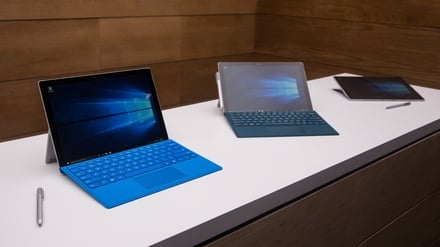By Will Goodbody, Science & Technology Correspondent
Little by little, Microsoft has in recent years been breaking into the tablet/laptop hybrid market with its Surface products.
At first, the device was a little ropey.
But the Surface has gradually matured into a really solid performing flexible tool, for both home and more especially for business use.
The latest version, the Surface Pro 4, has hit the shelves, and after a couple of days of using it, I was impressed.
Aesthetically, it hasn’t changed a great deal.
At 766-786 grams (depending on the model) and 8.45mm thick, it is both lighter and thinner than before.
The volume button has moved to the top from the side, following feedback from users.
The magnesium casing remains giving it a robust and premium look and feel, as does the multi-position-kickstand.
There’s also a full-size USB 3.0 port, a microSD card reader, a headset jack and Mini DisplayPort as before.
The previous 12” ClearType screen has been replaced with a 12.3” PixelSense, with higher resolution – and very good its too, with bright colour and great contrast and clarity, from all angles.
It works particularly well with the included Surface Pen, which has features like pressure sensitivity which changes the thickness of the line you are drawing depending on how hard you push, and also has four tip sizes.
Microsoft says the Pen’s battery life is up to a year when used for four hours on average a day thanks to a clever feature which shuts the pen down automatically when it is not in use.

The Surface Pro 4 has a slightly improved camera set up – a 5MP front facing HD unit as before and a new 8.0 MP rear-facing autofocus camera with 1080p HD video recording.
Both do exactly what it says on the tin - but let’s face it, you won’t be using them as your first choice camera every day.
From a security point of view the Surface Pro 4 supports the Windows Hello iris scan feature, and so there is a third front facing infrared camera for that.
Microsoft says the speakers on the Surface Pro 4 have been improved too.
They work fine, but there’s only so much quality you can get from a device of that size.
Inside it’s powered by a choice of 6th generation Intel Core M3, i5 or i7 processors and 4, 8 or 16GB of RAM.
As you’d expect, Windows 10 Pro generally runs smoothly on that powerful platform, though for some reason I did experience a couple of unexpected reboots while using it, which I could only attribute to teething problems.
The hard drive comes in a choice of 128GB, 256GB and 512GB and put all together, there’s a total of five combinations of hardware setup available in total.
The battery is said by Microsoft to be good for up to 9 hours of video playback – though I didn’t have the review unit for long enough to assess just how good or bad it is.
The Type Cover, which still has to be bought separately, has been revamped too.
Microsoft says it is now more of a laptop standard, with keys spaced out better and a 40% larger track pad featuring five multipoint touch.
It is certainly comfortable to use, and responsive – though it would want to be if the device is to fulfil its stated aim of being the “tablet that can replace your laptop”.
It is also backwards compatible, and so can be used with earlier versions of the Surface product.
Microsoft is also talking up the new docking station, which they say is more portable, has four full USB 3.0 ports, and 2 Mini Display Port sockets, an audio out and a 1GB Ethernet connection.
I didn’t get an opportunity to try it, so I can’t pass judgement on it.
In summary, the Surface Pro 4 is a really solid product and can justifiably lay claim to being a laptop replacement.
However, its cost will continue to put some off.
The cheapest low-spec option retails at €1029 (excluding keyboard which cost €155), rising to €2409 for the high end version.
And for that price pretty much every other alternative laptop/tablet option is open to you.
Comments welcome via Twitter to @willgoodbody

